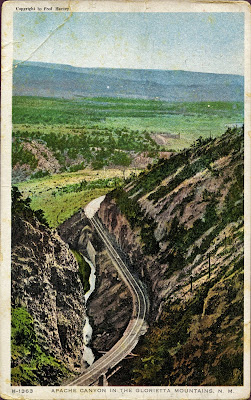Today's post card does not have a picture of any part of a train in it. Instead, there is an empty Santa Fe train track. I chose to collect this card because it is indicative of the type of terrain some of the trains in the Southwest United States had to traverse. A "bonus" feature is that it was near this canyon that the Battle of Glorietta Pass was fought during the Civil War. "Glorietta Pass and Apache Canyon are the site of the 1862 battle called "The Gettysburg of the West," when Union troops from nearby Fort Union, joined by volunteers from Colorado led by John Chivington, turned back a Confederate attempt to march north up the Rio Grande and capture the gold regions around Pikes Peak and Denver, Colorado." --- from http://www.pbs.org/weta/thewest/places/states/newmexico/nm_glorietta.htm The result of this battle was that New Mexico did not become a confederate territory. This post card is an example of the 1915 - 1930 era post card called the "White Border" era.
In the bottom left of the post card is the numbering: H-1363. This indicates to me that this was a post card printed by Curt Otto Teich for Fred Harvey. This is quickly confirmed by looking in the upper right hand corner where it says, "Copyright by Fred Harvey". The Harvey House was an oasis of comfort and civilization along the railway routes of the Southwest. Entrepeneur Fred Harvey, dismayed by the often crude facilities he had seen at railway stops, endeavored to provide clean and welcoming lunchrooms, restaurants, and hotels as alternatives. His name became synonymous with quality accommodations -- an image fostered by clever and attractive advertising which drew in tourists from around the world. The Harvey House chain also offered tours to cultural, geological, and archeological attractions, further opening the Southwest to visitors. Harvey had close connections with the Santa Fe Railway, contracting to provide dining services along the line; this mutually beneficial association allowed Harvey to use the railroad for free shipment of supplies, while providing railway passengers with quality rest stops. --- from https://abqlibrary.org/c.php?g=19363&p=108880
The back of the post card also confirms that this is a Fred Harvey post card. The message was typed onto the post card; don't see that very often, although I do have a couple of them. The date on the back that was typed in says it was written 110 years ago today.


No comments:
Post a Comment
If you know anything about the history of the cards, the trains or the locations, please add them.